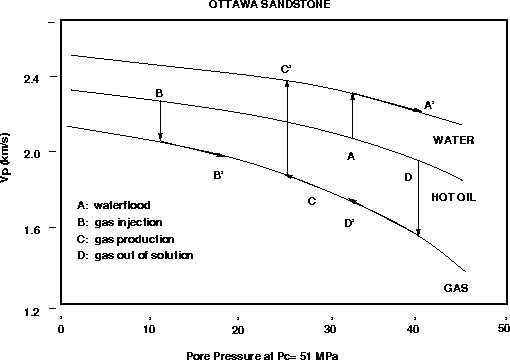Given the distribution of pore pressure and water saturation
as functions of time and distance from the water injectors,
we predict the associated compressional (P) and shear (S)
seismic velocities Vp, Vs and density
![]() throughout the reservoir at two stages of waterflood.
throughout the reservoir at two stages of waterflood.
The Stanford Rock Physics and Borehole Geophysics Project
(SRB) has conducted several
lab measurements of dry and saturated rocks at various pressures,
temperatures, and for variable pore-fluid saturants. Figure
![[*]](http://sepwww.stanford.edu/latex2html/cross_ref_motif.gif) shows some of the SRB lab results for the Ottawa
sand on which our reservoir study is based. The curve labeled
``GAS'' was obtained by measuring the bulk and shear moduli
K and
shows some of the SRB lab results for the Ottawa
sand on which our reservoir study is based. The curve labeled
``GAS'' was obtained by measuring the bulk and shear moduli
K and ![]() on an oven-dry sample of Ottawa sand, at a confining
pressure Pc of 51 MPa, at a reasonable reservoir temperature of
about 50 C. The fluid curves (water and oil) are calculated
from the dry data by means of the Gassmann fluid substitution equation
in order to predict the 100% fluid-saturated bulk and shear moduli
for the Ottawa sand for both hot oil and hot water as injectants.
This procedure is valid for predicting low frequency velocities such
as those encountered by surface seismic reflection data.
on an oven-dry sample of Ottawa sand, at a confining
pressure Pc of 51 MPa, at a reasonable reservoir temperature of
about 50 C. The fluid curves (water and oil) are calculated
from the dry data by means of the Gassmann fluid substitution equation
in order to predict the 100% fluid-saturated bulk and shear moduli
for the Ottawa sand for both hot oil and hot water as injectants.
This procedure is valid for predicting low frequency velocities such
as those encountered by surface seismic reflection data.
Gassmann's Equation relates dry elastic moduli to fluid-saturated elastic moduli. For bulk moduli, Gassmann (1951) found that
| |
(4) |
where M is a normalized ratio of mineral, fluid and dry bulk moduli such that
| |
(5) |
Equation (4) is a rearrangement of Equation 2.77 from Bourbié et al. (1987). Concerning shear moduli, Gassmann found no distinction between dry and saturated properties:
| |
(6) |
In the above expressions,
Km is the bulk modulus of the pure mineral skeleton,
Kf is the bulk modulus of the saturating fluid, and Kd is the bulk
modulus of the dry rock under study. Ks is the Gassmann theoretical
bulk modulus of the dry rock after complete saturation with wetting fluid.
Similarly, ![]() is the Gassmann theoretical shear modulus predicted
to be the same as the dry bulk shear modulus
is the Gassmann theoretical shear modulus predicted
to be the same as the dry bulk shear modulus ![]() .The underlying assumptions in Gassmann's Equation are:
.The underlying assumptions in Gassmann's Equation are:
Figure ![[*]](http://sepwww.stanford.edu/latex2html/cross_ref_motif.gif) shows the resulting P-wave velocity versus pore
pressure paths
for Ottawa sand under various types of reservoir production processes.
For our study, we consider the ``waterflood'' process, labeled A, A'.
Figure
shows the resulting P-wave velocity versus pore
pressure paths
for Ottawa sand under various types of reservoir production processes.
For our study, we consider the ``waterflood'' process, labeled A, A'.
Figure ![[*]](http://sepwww.stanford.edu/latex2html/cross_ref_motif.gif) shows that there is a net increase in Vp
of about 10% as
water is injected to increase effective reservoir pore pressure, and
hot oil is replaced with hot water. Given the pore pressure and water
saturation data from the fluid flow simulation, we use the dry data
in Figure
shows that there is a net increase in Vp
of about 10% as
water is injected to increase effective reservoir pore pressure, and
hot oil is replaced with hot water. Given the pore pressure and water
saturation data from the fluid flow simulation, we use the dry data
in Figure ![[*]](http://sepwww.stanford.edu/latex2html/cross_ref_motif.gif) and the Gassmann relation (4) to
predict the partially saturated shear and bulk moduli as a
function of distance from the water injection well.
Given the predicted Ks(r,t) and
and the Gassmann relation (4) to
predict the partially saturated shear and bulk moduli as a
function of distance from the water injection well.
Given the predicted Ks(r,t) and ![]() , we calculate the
P and S low frequency seismic velocities as:
, we calculate the
P and S low frequency seismic velocities as:
| |
(7) |
and
| |
(8) |
where the subscript ``s'' refers to a saturated quantity.
Using this technique, we calculate pore pressure, water saturation, P-wave velocity, S-wave velocity and density, as a function of distance from the well and injection duration time, in an Ottawa sand reservoir at 50 C under two phases of waterflood injection.
 |